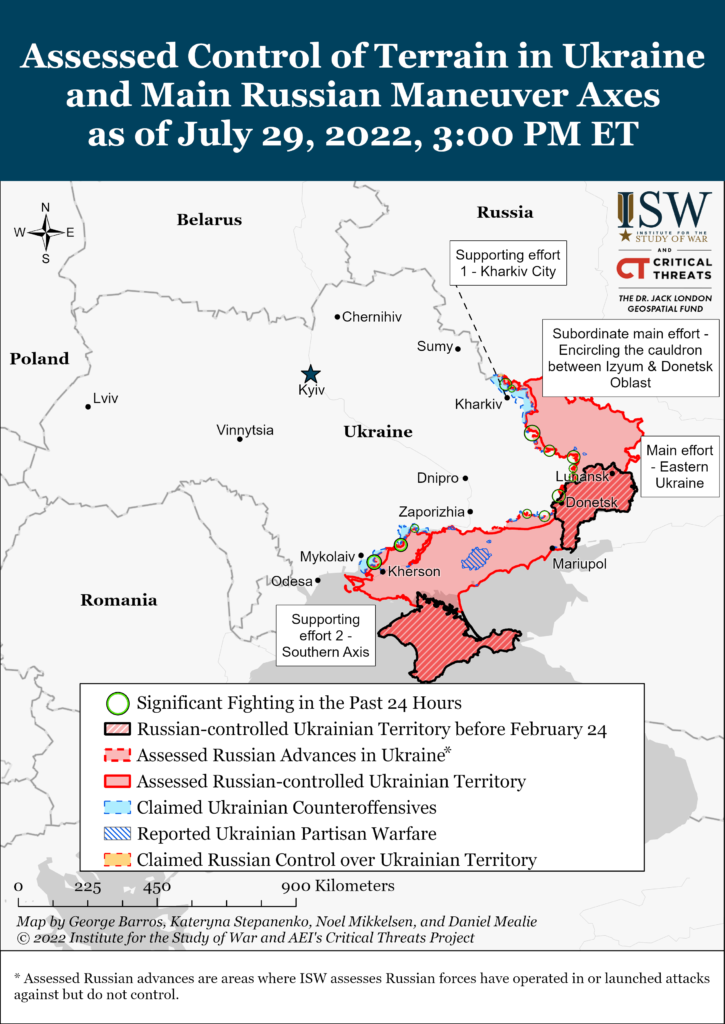Dynamics over time are the key to analyzing just about anything, and they clearly favor Ukraine in Russia’s failing war of conquest
(Russian/Русский перевод) By Brian E. Frydenborg (Twitter @bfry1981, LinkedIn, Facebook), July 30, 2022; adapted version featured by Small Wars Journal on August 4 in Why Ukraine Will Defeat Russia and How, from Kherson to Crimea, from Zaporizhzhia to the Donbas, in turn cited by the German news site Buzzard; *update August 1: a key reaction with some additional information is briefly discussed; originally submitted July 18 to a prestigious think tank for publication and which a kindly editor there said he intended to review/edit, but, despite a cordial-back-and-forth via e-mail in the interim, twelve days later that still has not happened (understandably a lot going on at the other end) so here I am self-publishing (oh, the perils of freelancing!). I think it stands well as is, so I have kept the text the same from July 18 (I had made one time-related change but had made the wrong calculation, so 100% of the text before the update is the same from July 18 after my correction), but with a small number of additional sources added and some of the images updated. You can see that almost-identical version from July 18 with metadata showing that date here. Also see the sister August 3 article How Ukraine War Will Likely Go Rest of 2022, or, Kherson: The Beginning of the End for Russia and July 14 precursor article, THE THREE MAPS SHOWING WHY UKRAINE IS WINNING AND RUSSIA IS LOSING (and why is isn’t even close); follow-up piece on how specifically these dynamics will play out over the course of the next few months coming very soon.
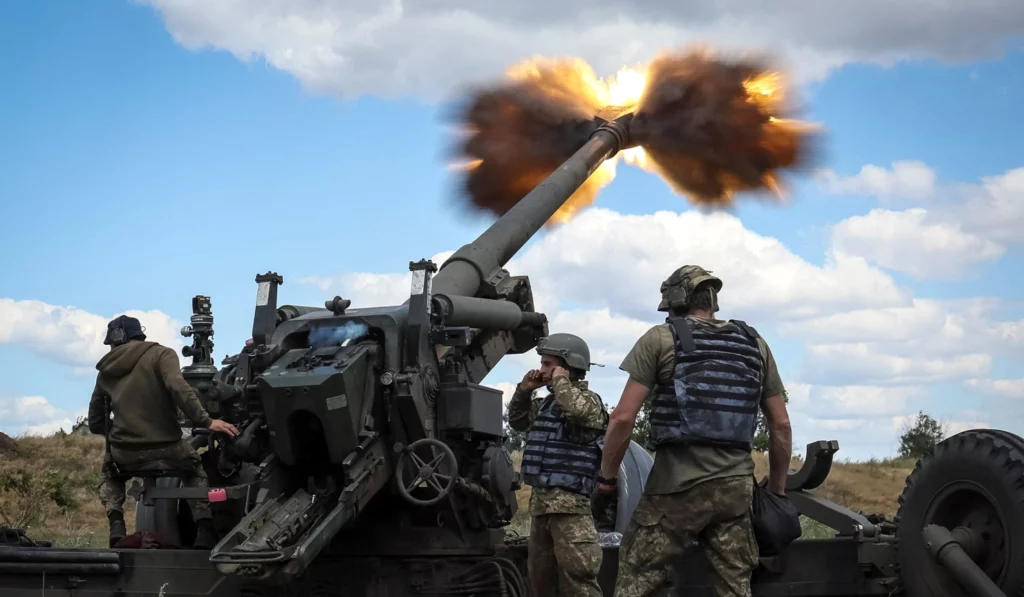
SILVER SPRING and WASHINGTON—I can respect the fact that many journalists are not terribly steeped in military history, strategy, or tactics, but the writing really is on the wall for Russia in its miserable failure of a war. And while projecting too much optimism may run the risk losing a needed sense of urgency in some quarters, support for Ukraine has not only been stated as a clear and long-term commitment throughout the West but acted upon with vigor over the more than five months of this war, with support only increasing and more and more support surely on the way. Thus, analysis that misses Ukraine’s success—not just past or tactically, but in forging, driving, and dominating dynamics that have put Ukraine on the path to surprising victory and Russia on the path to ignominious defeat—is not presenting an accurate picture.
As I noted elsewhere, a simple look at a few maps produced by the Institute for the Study of War in conjunction with Critical Threats reveals that, since late March, Ukraine has been more on the offensive than Russia and is taking far more of its occupied territory from Russia since then than territory Russia has taken since then from Ukraine, never a good sign for any invader.
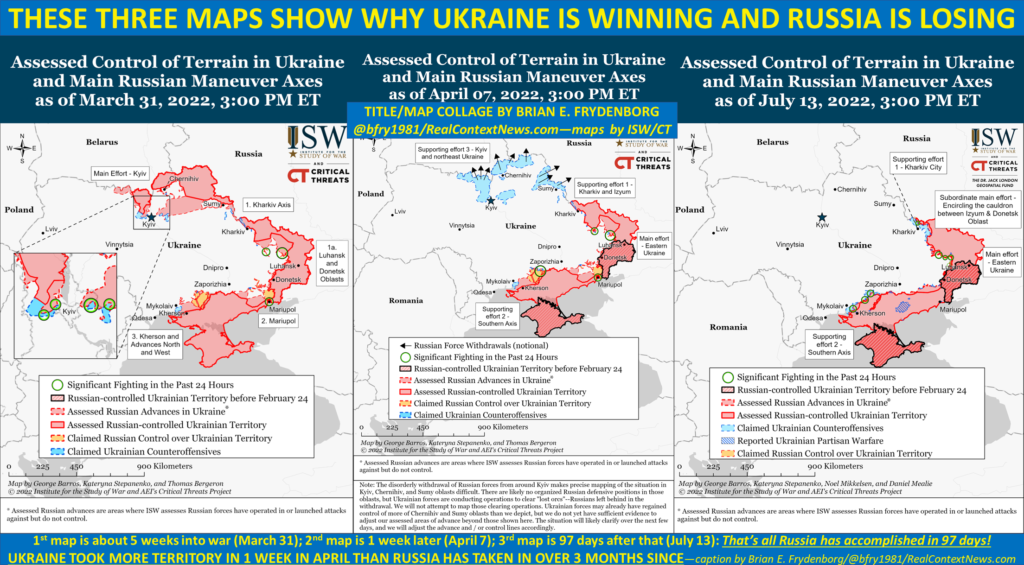
What this demonstrates is that Russia has essentially lost the ability to dramatically alter the dynamics of the war. After Russia was routed in late March and early April from the Kyiv, Chernihiv, and Sumy fronts, the supposedly-mighty Russian Army has for months now—more than three—been able to do little more than inch forward kilometer by kilometer in the east, attack defenseless civilians (or even wheat fields), blockade Ukrainian ports, and lob cruise missiles from extreme distances.
Tactical Realities Dictating Russia’s Shrinking Strategic Outlook
At this point, the Russians’ greatest battlefield asset is their massed artillery barrages (Russia, surprisingly, was never able to achieve air superiority and Ukrainian air defenses are only increasing and improving with Western aid). And yet, Ukrainian tactics and new Western equipment (M777 howitzers, M142 HIMARS [High Mobility Artillery Rocket System], M270 MLRS [Multiple Rocket Launch System])—equipment literally designed to counter the very equipment the Russians are using—have been an effective counter to undermine this major Russian strength. The more dispersed and nimble Ukrainians are careful about concentrating many soldiers in vulnerable areas while Russians keep offering up packed headquarters with key officers and ammunition depots as easy targets, both crucial for effective use of Russian artillery (and just about everything else Russia has). And, indeed, the new Western precision systems and ammunition that are being given (and given in increasing numbers to Ukraine), combined with Ukraine’s innovative and brilliant approach to targeting (an app called GIS Art for Artillery), are already outperforming and outgunning Russian imprecise “aim-in-the-general-area” artillery, inflicting far more military casualties per gun per shot than the Russians, including destroying far more Russian artillery pieces along with the ammunition needed to supply them and Russian S-300 or S-400 air defense systems that seem unable to counter the Western weapons. The new systems are also further disrupting already severely disrupted Russian supply lines. In recent weeks, as the new Western weapons have been increasingly rolled out by Ukraine, apart from high Russian casualties, there has also been a telling exponential decrease in outgoing Russian artillery rounds even as Ukraine increases its outgoing fire, the result of weeks of precise and effective targeting by—and an increase in the numbers of—these Western-supplied weapons systems, with more of these systems on the way.
In this context, it is crucial to note that, at this point, most of Russia’s best combat infantry troops are dead, wounded, or in units that have been “mauled” into a non-“combat effective” state through casualties, leadership voids, equipment and supply losses/shortages, or a combination (often so) of these. In a wider sense, Russia’s endemic corruption very much infecting its military and Russia’s strange conscript-contract hybrid military system contributing to a severe lack of cohesion are big parts of the explanation for these losses. And the overall numbers of massive casualties suffered by Russia and its Donbas Luhansk and Donetsk proxies along with equipment losses (including catastrophic losses of Russia’s poorly-maintained supply trucks) and ridiculous, consistent supply issues mean that Russia’s outsized imperial ambitions far exceed its current and foreseeable capabilities.
Even so, Russia and those Donbas proxies are resorting to drafting locals in regions of Ukraine they occupy while Russia is also pushing hard to raise troops from remote parts of the Russian Federation populated by down-and-out ethnic minorities and pressure veterans whose contracts are up or have already returned home from combat to go back (getting new recruits in Russia is not as simple or as quick as one may think), and even this will take time and will result in most cases in reluctant, poorly trained-and-equipped troops with low morale or people who will simply surrender or defect at worst. In some cases, troops are even WWII-era or even late-nineteenth-century bolt-action rifles or are manning obsolete Soviet-era relic tanks recently taken out of storage, most notably the T-62M 1983 upgrade of the 1961 T-62, built upon the 1958 T-55 (this last point strongly suggests that Russia has lost most of its best deployable tanks, or why else would they be dragging out much older Soviet tanks from storage?). Obviously, none of these new soldiers or units will be anywhere near the quality of the best troops and units that have already been decimated or destroyed in the fighting: those elite troops are basically irreplaceable.
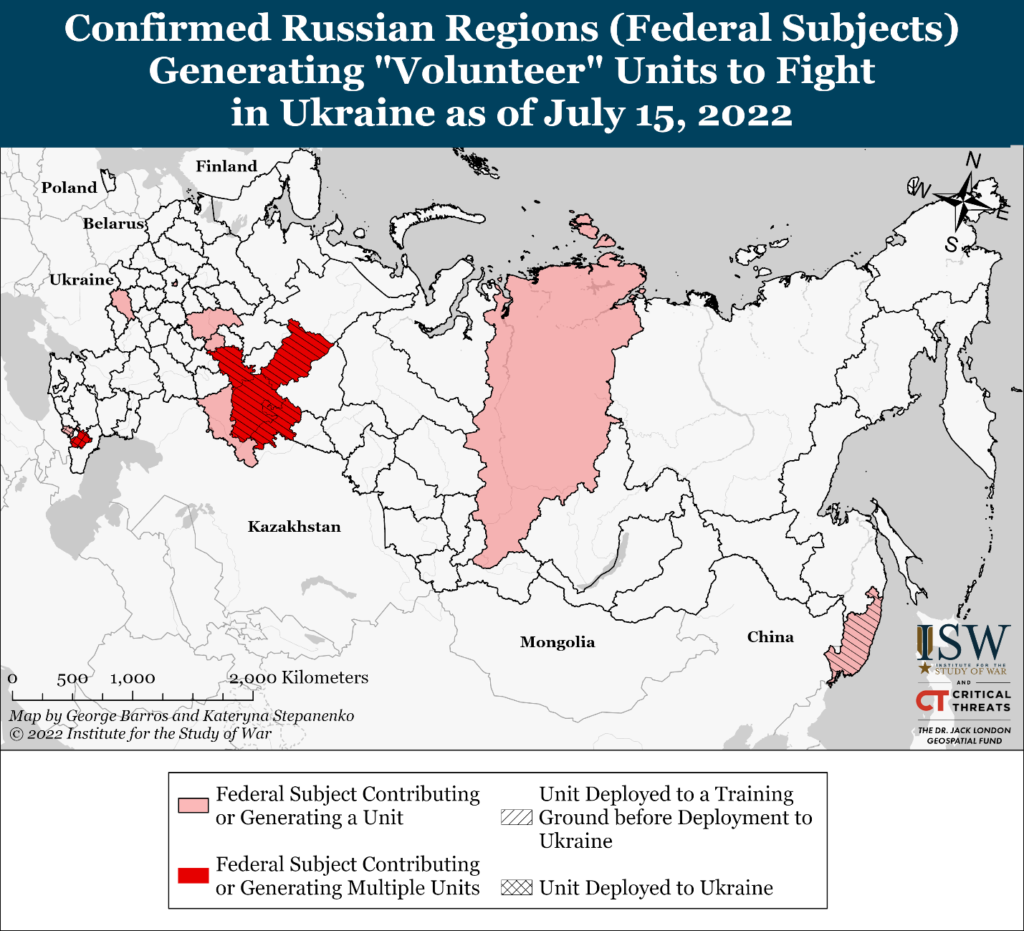
None of these moves by Russia reflect winning.
Thus, there simply are currently no good, fast options to replace Russia’s mounting casualties and Russia is basically running out of not just quality troops, but troops in general. There are not 50,000—let alone 20,000—fresh Russian elite combat forces arriving well-equipped and well-supplied with high-morale and quality leadership at Russia’s fronts anytime soon, and Russia’s current leadership culture is incapable of patiently and methodically training any large numbers of high-quality troops, especially in its current flailing mode. Even if Russia’s leaders were focusing on producing well-trained troops, it would be a long time before they could be deployable, maybe even too late to prevent a full loss of all Russian gains in Ukraine since 2014, let alone 2022. It is also crucial to note that Russia’s military machinery cannot be properly maintained or produced anymore without key components manufactured outside of Russia and blocked by Western sanctions. Even if Russian President Vladimir Putin hits the panic button and begins a general draft mobilization (politically risky for him), that cannot yield serious results anytime soon, either.
*Update August 1: one of the Twitter accounts to follow on the Ukraine war—Trent Telenko, a former U.S. Department of Defense civilian logistics expert—had high praise for this article after I shared it with him, and responded with a thoughtful thread full of additional information on Russian manpower shortcomings. He cited the his analysis (as I have done throughout this article) and that of Kamil Galeev; Telenko has earlier shared two key threads by Galeev, one going into the overall nature of Russian imperialism and how that effects its force composition, deployment, and how casualties are spread across certain peoples, geographies, and units, and another on how the nature of Russian imperialism means that much of Russia is not that Russian, with implications for recruitment/force composition/identity.*
And, as well-known Russia expert Fiona Hill notes, time is not on Russia’s side: as the quality, capability, outfitting, and morale of Russian troops decrease, the inverse is happening with the Ukrainian military which, even before this current stage of fighting, was qualitatively superior (I have explained before that Ukraine actually has more troops than Russia, that these troops are better equipped and supplied, with higher morale, better and simpler logistics, home field advantage, and major international support and aid that Russia lacks). Ukraine is now only deploying more and more troops with high-morale and Western-style (or even actual Western) training with some of the best Western equipment available, easily overmatching corresponding Russian troops and technology. This trend began years ago with Western training missions, funding, and equipment for Ukraine’s military, efforts that have only dramatically intensified during this current crisis. And that acceleration is happening as Russia is increasingly rushing ill-trained raw recruits with inferior equipment against superior Ukrainian forces, with predictable results. Ukraine may have less of this new technology than Russia has of its inferior technology, but even this imbalance is being mitigated with each new delivery of Western military aid.
Whatever advances Russia has managed to accomplish in recent months have been painstakingly slow, relatively miniscule, and “uneven”—part of a village or two one day, repulsed another, some small loss of territory after that, a village following that: as representative of Russia’s extremely limited capabilities as anything else and proof its “culminating point” hovers over its operations like an albatross—and even those gains have come at high cost. Any hypothetical major gains would mean its “exhausted,” bloodied troops will be spread out more thinly, its poorly-managed supply lines extended over longer distances and open that much more to Ukrainian attacks: in other words, not only are any new Russian gains not only not guaranteed to stay in Russian hands long, they make holding onto what Russia held before more challenging and open Russia even more so to counterattacks.
Even where Russia has gained ground, there has been destruction and massive depopulation—including population transfers by Russia deporting Ukrainians to Russia, acts that could legally be considered genocidal (such transfers are a horrific Russian tradition in Ukraine, as I have noted before)—accompanied by looting and war crimes on a large scale. Yet Ukraine has already received concrete pledges of reconstruction—with individual regions even being “adopted” by individual allies—while Russia’s extremely-sanctioned economy and lines of outside support are weak, any “allies” practically non-existent.
Examined Closely, Dynamics Obviously Favor Ukraine and Will for Foreseeable Future
In short, this is the best Russia has been able to do and the capabilities of its war machine are only set to decline further while Ukraine’s military is only increasing its capabilities, with the above factors almost mathematical in terms of their combined effects. Russia simply cannot sustain and supply its current efforts spread out across such wide fronts, let alone find fresh, motivated, and well-trained recruits and new state-of-the-art equipment (indeed, it is already losing ground in the south in the face of the buildup of what is supposed to be a massive Ukrainian counteroffensive there, one that could see Kherson retaken and even put Crimea in play, as I posited in April). In contrast, Ukraine is set for new waves of well-trained troops and the deployment of much larger additions to the less-trained but still highly-motivated Territorial Defense Forces even as wave after wave of Western equipment arrives.
Non-expert news anchors and journalists should familiarize themselves with these dynamics and how they so deeply favor Ukraine. To be sure, Russia certainly possesses horrific, imprecise weapons that can kill many civilians when deployed indiscriminately against concentrated urban areas, but that does not equate to rosier prospects on the battlefield, a coherent strategy, sound allocation of resources, effective logistical organization, motivating men to perform well as coordinated teams, and an incoming abundance of both new motivated recruits and cutting-edge modern equipment that stack up very well against opposing forces. Ukraine has all of these things, Russia none of them.
As I wrote, the writing is on the wall. Russia is not some magical fantasy power, capable of using sorcery to concoct armies led by fearsome undead Nazgûl Ringwraiths with an endless supply of bloodthirsty orcs. The world, and especially Ukraine, has seen what this Russian enemy has to offer, and it is not impressive. In contrast, the Ukrainians are most impressive, and—in spite of their own not insignificant losses and the terror of Russia’s crimes against humanity targeting defenseless civilians—they are the ones who will shape the way this war will change in the coming months, driving dynamics that are very much in their favor. It is time that the analysis given to the public reflects this reality, especially with Western support clearly continuing and increasing.
This article mainly constitutes the “why” Russia will lose; the sister follow-up article: the “how!”
See all of Brian’s Ukraine coverage here and his July 14 precursor article, THE THREE MAPS SHOWING WHY UKRAINE IS WINNING AND RUSSIA IS LOSING (and why is isn’t even close)
© 2022 Brian E. Frydenborg all rights reserved, permission required for republication, attributed quotations welcome
Also see Brian’s eBook, A Song of Gas and Politics: How Ukraine Is at the Center of Trump-Russia, or, Ukrainegate: A “New” Phase in the Trump-Russia Saga Made from Recycled Materials, available for Amazon Kindle and Barnes & Noble Nook (preview here), and be sure to check out Brian’s new podcast!
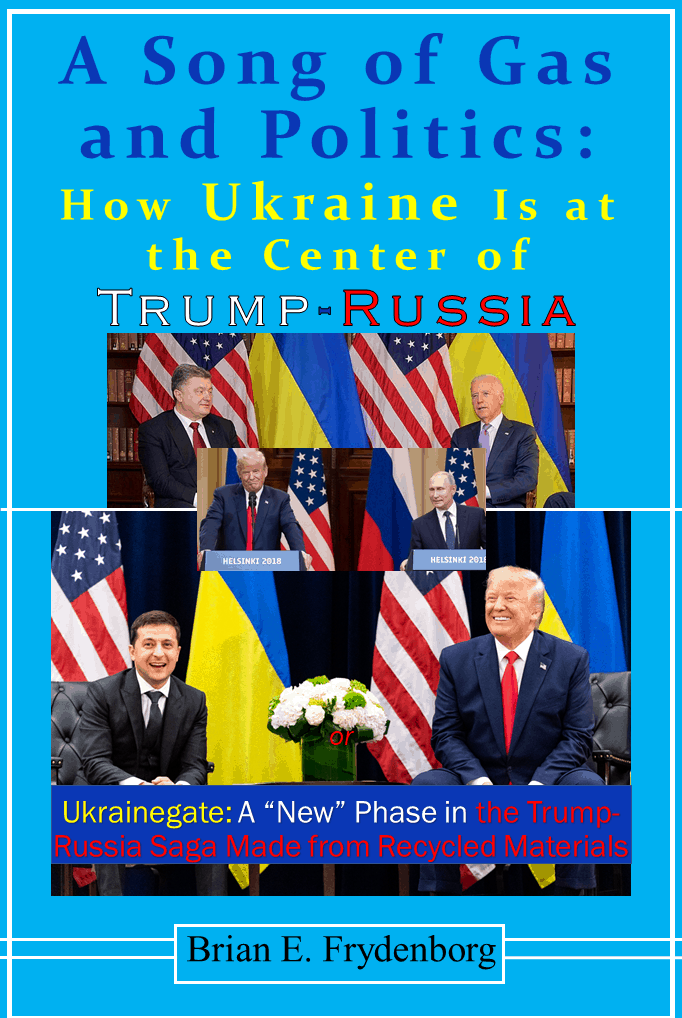
If you appreciate Brian’s unique content, you can support him and his work by donating here; because of YOU, Real Context News surpassed half-a-million content views on 8/27/22!!
Feel free to share and repost this article on LinkedIn, Facebook, and Twitter. If you think your site or another would be a good place for this or would like to have Brian generate content for you, your site, or your organization, please do not hesitate to reach out to him!
